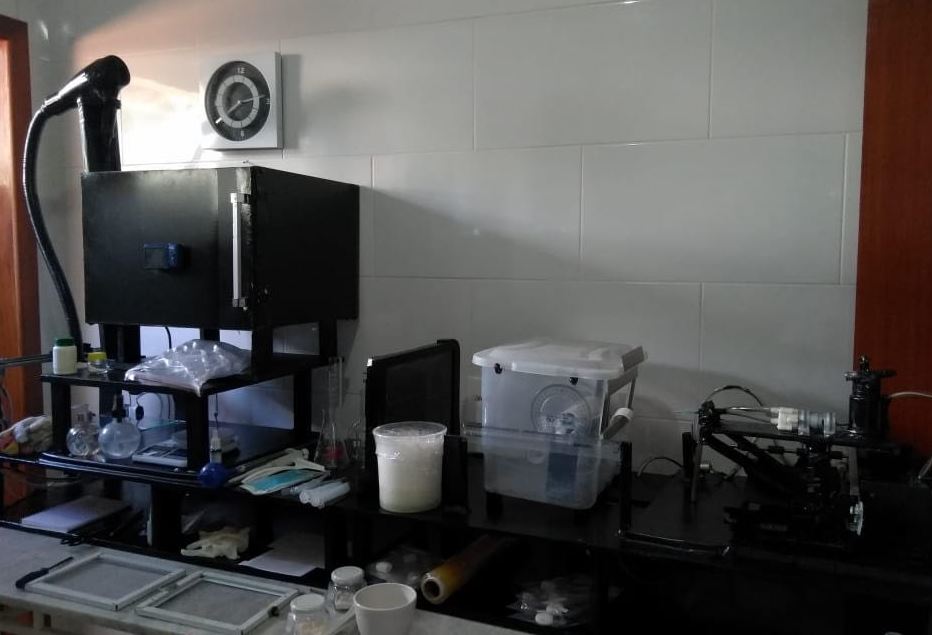Device/prototype production of synthetization of scaffolds the base of fibroin and Aloe barbadensis
DOI:
https://doi.org/10.20873/jbb.uft.cemaf.v8n1.cortelettiPalabras clave:
device, tissue engineering, scaffoldsResumen
This research established itself as principle the building of a device/prototype specific for synthesis of scaffolds composed of gel Aloe barbadensis Miller and fibroin extracted from cocoons of Bombyx mori, elaborate in favor of the development of equivalents dermo-epidermal. Consisting of an experimental study, with materials selection and related equipment, projection and construction of a prototype aiming at processing on larger scale and the best cost-benefit ratio, making the final product more accessible for those who need.In this way,the development of the device/prototypewas carried outnoting his performance in the process,being necessarythe conducting analyses physicochemical and microbiological of the scaffolds produced.
Citas
Ahsan T, Nerem RM. Bioengineered tissues: the science, the technology, and the industry. Orthodontic & Craniofacial Clinical and Translational Research. v.8, n.3, p134-140, 2005.
https://doi.org/10.1111/j.1601-6343.2005.00326.x
Chan BP, Leong KW. Scaffolding in tissue engineering: gen-eral approaches and tissue-specific considerations. European Spine Journal. v.17, n.4, p467-479, 2008.
https://doi.org/10.1007/s00586-008-0745-3
Chan G, Mooney DJ. New materials for tissue engineering: towards greater control over the biological response. Trendsin Biotechnology. v.26, n.7, p382-392, 2008.
https://doi.org/10.1016/j.tibtech.2008.03.011
Ma D, Wang Y, Dai W. Silk fibroin-based biomaterials for musculoskeletal tissue engineering.Materials Science and Engineering. v.89, n.1, p456-469, 2018.
https://doi.org/10.1016/j.msec.2018.04.062
Ma PX. Scaffolds for tissue fabrication. Materials Today. v.7, n.5, p30-40, 2004.
https://doi.org/10.1016/S1369-7021(04)00233-0
Moroni L, Elisseeff JH. Biomaterials engineered for integra-tion. Materials Today. v.11, n.5, p44-51, 2008.
https://doi.org/10.1016/S1369-7021(08)70089-0
O'Brien FJ. Biomaterials & scaffolds for tissue engineering. Materials Today. v.14, n.3, p88-95, 2011.
https://doi.org/10.1016/S1369-7021(11)70058-X
Polak DJ. Regenerative medicine. Opportunities and challeng-es: a brief overview. Journal of the Royal Society. v.7, n.6, p777-781, 2010.
https://doi.org/10.1098/rsif.2010.0362.focus
Rodrigues BFFS. Engenharia de tecidos para regeneração da pele: retrospectiva e perspectivas futuras. Ano de obtenção: 2012. 68p. Dissertação (Mestrado Integrado em Ciências Farmacêuticas) – Universidade Fernando Pessoa, Porto.
Sachlos E, Czernuszka JT. Making Tissue Engineering Scaf-folds Work. Review: The application of solid freeform fab-rication technology to the production of tissue engineering scaffolds. v.5,p29-40, 2003.
https://doi.org/10.22203/eCM.v005a03
Turnbull G, Clarke J, Picard F, Riches P, Jia L, Han E, Li B, Shu W. 3D bioactive composite scaffolds for bone tissue engineering. Bioactive Materials. v.3, n.3, p278-314, 2018.
https://doi.org/10.1016/j.bioactmat.2017.10.001
Vunjak-Novakovic G, Kaplan DL. Tissue Engineering: The Next Generation. Tissue Engineering. v.12, n.12, p.3261-3263, 2006.
https://doi.org/10.1089/ten.2006.12.3261
Yildirimer L, Thanh NTK, Seifalian AM. Skin regeneration scaffolds: a multimodal bottom-up approach. Trends in Bio-technology. v.30, n.12, p.638-648, 2012.
https://doi.org/10.1016/j.tibtech.2012.08.004
Zhang Z, Gupte MJ, Ma PX. Biomaterials and stem cells for tissue engineering. v.13, n.4, p.527-540, 2013.

Descargas
Publicado
Cómo citar
Número
Sección
Licencia
Copyright (c) 2024 - Journal of Biotechnology and Biodiversity

Esta obra está bajo una Licencia Creative Commons Atribución 4.0 Internacional.
Los autores que publican en esta revista aceptan los siguientes términos:
Los autores mantienen los derechos autorales y conceden a la revista el derecho de primera publicación, con el trabajo simultáneamente licenciado bajo la LicenciaCreative Commons Attribution (CC BY 4.0 en el link http://creativecommons.org/licenses/by/4.0/) que permite compartir el trabajo con reconocimiento de la autoría y publicación inicial en esta revista.
Los autores tienen autorización para asumir contratos adicionales separadamente, para distribución no exclusiva de la versión del trabajo publicado en esta revista (ej.: publicar en repositorio institucional o como capítulo de libro), con reconocimiento de autoría y publicación inicial en esta revista.
A los autores se les permite, y son estimulados, a publicar y distribuir su trabajo online (ej.: en repositorios institucionales o en su página personal) en cualquier punto antes o durante el proceso editorial, ya que esto puede generar alteraciones productivas, bien como aumentar el impacto y la citación del trabajo publicado (disponible en El Efecto del Acceso Libre en el link http://opcit.eprints.org/oacitation-biblio.html).


